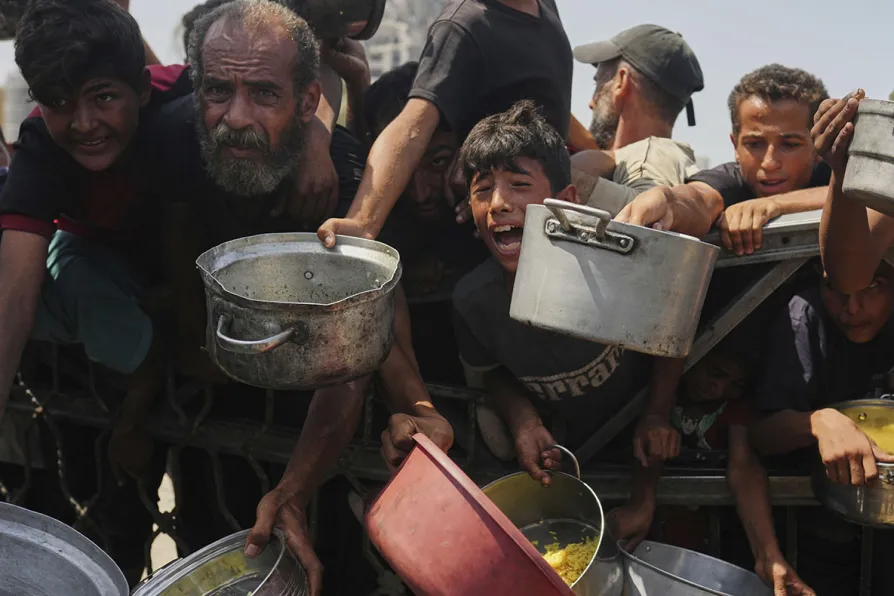The long-term effects of chemical weapons such as Agent Orange mean that the impact of war lasts well beyond a ceasefire
For those in the West, hunger is often just the familiar feeling of a growling stomach between meals — in Gaza, it has become a strategic weapon of slow, systematic and deadly destruction, writes MARC VANDEPITTE

 Palestinians struggle to get donated food at a community kitchen in Gaza City, northern Gaza Strip, August 16, 2025
Palestinians struggle to get donated food at a community kitchen in Gaza City, northern Gaza Strip, August 16, 2025
WITH OUR full refrigerators, we in the West have no real understanding of what true hunger means. A prolonged lack of calories and essential nutrients is a profound horror and one of the most terrible things a person can endure.
In Gaza, hunger has evolved into a weapon of war, and the inhabitants are now living in a hell.
According to the World Food Programme, the two million people in Gaza require 62,000 tons of food each month. Yet, from March to July, Israel allowed an average of only 20,000 tons, which is barely 32 per cent of what is needed. For months, no food was permitted into the northern half of Gaza at all.
The shortage isn’t just about calories; there is an acute lack of essential nutrients. Since March, Israel has allowed in only 136 tons of meat. Bread is scarce as most bakeries have been shut down due to a lack of flour and fuel. Vegetables and fruit are virtually non-existent.
The highly publicised food drops by some countries are “as useful as fighting a forest fire with a garden hose,” a statement from Immade Annouri that rings true. Over the past few weeks, only about 180 tons of aid were dropped, which is less than 0.1 per cent of the aid delivered after the February ceasefire.
The infamous Gaza Humanitarian Foundation, which was co-founded by Israel, distributes meagre food parcels in southern and central Gaza. Even if their figures are to be believed, this amounts to less than 0.7 meals per person per day.
The consequences are appalling. Children are being born underweight or are dying before birth. Between January and June, there were 222 stillbirths, a tenfold increase from the pre-war period. One in five babies is now malnourished or born prematurely, and one in three pregnancies is now considered high-risk.
From April to July, 20,000 children were hospitalised with acute malnutrition. Their immune systems are failing, making them more vulnerable to disease. Some have even been struck by the rare Guillain-Barre syndrome, which is possibly linked to hunger and can cause muscle weakness, paralysis, and respiratory issues.
More and more people in Gaza are succumbing to this organised famine. As of now, 263 hunger-related deaths have been counted, including 112 children. This is only the beginning, and the long-term consequences are expected to be profound.
Child murder
Due to the widespread shortage of essential nutrients, children’s brains are not developing properly. The current malnutrition puts every child in Gaza at lifelong risk of poor health. Research indicates that adults who were malnourished in their youth are more likely to suffer from heart disease, diabetes and intellectual delays.
Hunger disproportionately affects children. The children of Gaza are being deliberately targeted because they represent a growing, young Palestinian population — a demographic challenge for Israel. Attacking children is more than a war crime; it is a deliberate strategy to undermine the social and cultural continuity of the Palestinian community.
By killing children or drastically reducing their chances of survival through bombing, starvation and the destruction of health facilities, the community as a whole is disrupted and its future is jeopardised.
This constitutes a double genocide: a rapid one through violence and a slow one through the destruction of the very conditions necessary for life. Gaza is paying a price today that will be felt for generations to come.
Destruction and despair
In addition to hunger, there is destruction on an unprecedented scale. More than 70 per cent of Gaza’s infrastructure lies in ruins. The UN estimates that reconstruction will cost at least $53 billion, which is about 20 times the GDP. However, this figure is a rough estimate, and the true extent of the damage is almost inconceivable.
The economy is completely paralysed. The agricultural sector has been almost entirely destroyed. According to the UN, 84 per cent of agricultural land has been damaged, along with 71 per cent of greenhouses. Livestock is nearly non-existent. Fishermen are surviving by eating turtles and weeds.
Mainstream
Even in the near future, Gaza will remain almost entirely dependent on foreign aid for its food. But there is more to it than that. The near-total destruction of infrastructure has made life in Gaza simply unlivable, which is precisely the intention.
The massive destruction, the starvation of civilians, the killing of children, the obstruction of medical care, and the blocking of food aid all fit into a pattern of extermination and genocide.
The Israeli government is not attempting to hide its intentions. Leaked cabinet transcript states in black and white that starvation is a deliberately chosen strategy.
Far-right ministers like Bezalel Smotrich openly speak of ethnic cleansing. He has declared that the war would only end once “Gaza is cleansed of Hamas and hundreds of thousands of Gazans are on their way out of it to other countries.”
While one might expect such rhetoric from a far-right cabinet, it’s worse that the Israeli population largely approves of it. Four out of five Jewish Israelis say they are indifferent to the famine in Gaza, and 82 per cent want Palestinians to be expelled from the Gaza Strip.
The belief that there are no innocent civilians in Gaza, including children and women, is shared by two-thirds of the Israeli population.
In other words, the government’s policy is not an extremist fringe position; it has become mainstream. This policy is supported by Donald Trump, who has called on Israel to finish the job: “It got to a point where you’re going to have to finish the job… They’re going to have to clean it up.”
Shocking
What is most shocking is not just the hunger or the violence itself, but our response to it — or rather, the lack thereof. While thousands of people are being starved, slaughtered and displaced right before our eyes, the West is looking the other way.
We offer little more than verbal protests, cynical food drops and a few crocodile tears. Our governments have refrained from economic or diplomatic sanctions and continue to politically support this genocidal regime. Our moral bankruptcy could not be greater.

The catastrophe unfolding in Gaza – where Palestinians are freezing to death in tents – is not a natural disaster but a calculated outcome of Israel’s ongoing blockade, aid restrictions and continued violence, argues CLAUDIA WEBBE

The people of Palestine need our solidarity in actions not words – trade unionists must give them our full support in their darkest hour, writes DANIEL KEBEDE

ANSELM ELDERGILL draws attention to a legal case on Tuesday in which a human rights group is challenging the government’s decision to allow the sale of weapons used against Palestinians

Israel continues to operate with impunity in what seems to be a brutal and protracted experiment, while much of the world looks on, says RAMZY BAROUD










